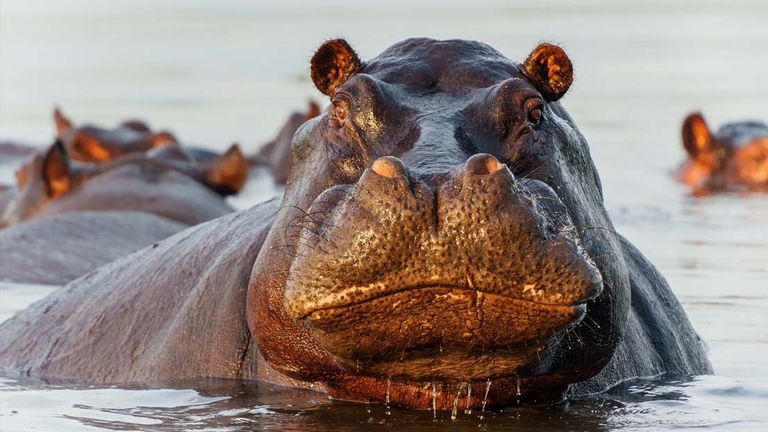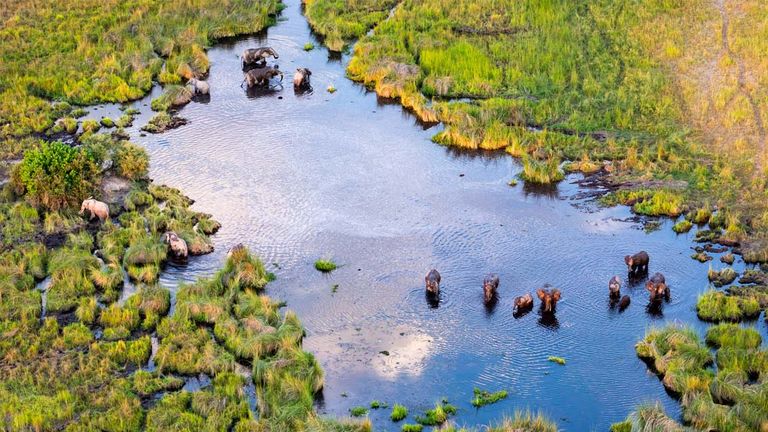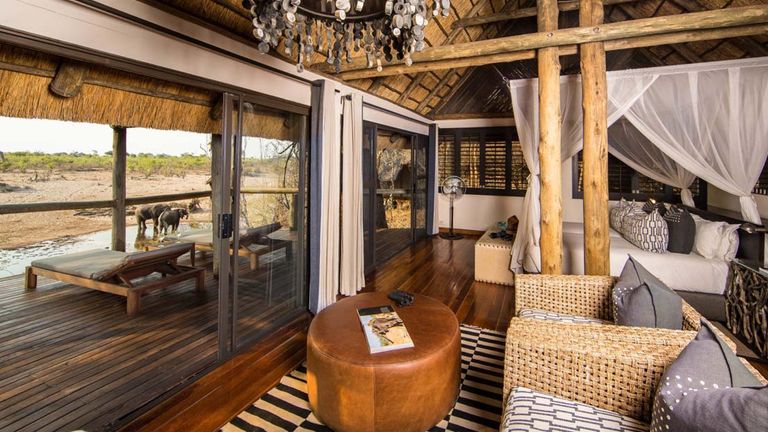Curious eyes peered at me from just above the surface of the river. Behind them, a wiggle of wet ears spattered water away. The features moved slowly and cautiously toward the boat I was floating in, its engine off so we could hear the sounds of nearby African frogs and kingfishers.
And then, those lurking eyes and ears raised to reveal the entire head of a hippopotamus: first, its round, protruding nostrils; then, its massive mouth — the largest mouth of all land animals. Suddenly, its jaws opened for a giant yawn. I saw its teeth, with long, deadly canines, and river water escaping down its chin. It was an astounding sight to behold, albeit a warning sign that we should probably leave the hippo and its pod in peace — after snapping a few photos, of course.
 Hippo sightings are a highlight of a visit to the Okavango Delta in Botswana.
Hippo sightings are a highlight of a visit to the Okavango Delta in Botswana.
Credit: 2023 henk bogaard/stock.adobe.com
Cartoons may depict hippos to be cute, chubby animals, but in person, their presence is formidable; some adults are about the size of a small car, and they’re one of the most dangerous land animals, killing some 500 people every year.
Hippo sightings are also one of the amazing highlights of an African safari. Here’s how to have a next-level wildlife experience in Botswana.
A Premier Safari Destination
Landlocked between Namibia and Zambia, the southern African country of Botswana features the Okavango Delta — the world’s largest inland delta — a huge expanse of fertile ground and lush marshland that sustains a bounty of animal life.
The delta is a result of Botswana’s Okavango River; while many of the world’s rivers begin in mountainous highlands, snake their way across land and empty out into a larger body of water, the Okavango is fed by the rain-fueled rivers of the Angolan Highlands and simply ends in the middle of the Kalahari Desert. Poetically, it’s known as “the river that never reaches the sea.”
The Okavango Delta’s abundance of flora and fauna has made it a premier destination for safari companies such as Desert & Delta Safaris, and other areas across the semi-arid Kalahari Desert region of northern Botswana are also great destinations for spotting wildlife.
Because the country is landlocked and requires a little more effort to get to, it has become popular among higher-end luxury safari outfitters, and it tends to attract safari veterans who have "been there, done that” at the popular parks in coastal African countries (think: Tanzania’s Serengeti National Park, Kenya’s Masai Mara National Reserve and South Africa’s Kruger National Park).
But whether your client has five safaris under their belt or is entirely new to the travel type, Botswana is an amazing place for anyone who wants to see a multitude of wildlife.
The Okavango Delta
For those who want a thrilling hippo sighting like mine, these typically happen near a water source — and there’s no grander water source in the safari world than the Okavango Delta. Hailed as the “Jewel of the Kalahari,” this giant oasis with UNESCO World Heritage status is the raison d'etre for traveling to Botswana.
 The Okavango Delta is the world's largest inland delta and supports hundreds of mammals and more than one thousand species.
The Okavango Delta is the world's largest inland delta and supports hundreds of mammals and more than one thousand species.
Credit: 2023 Ondrej/stock.adobe.comThe freshwater wetland is home to some 130 species of mammals, 150 species of fish and reptiles and 480 species of birds. The delta’s waters sustain more than one thousand species of plants, such as water lilies and papyrus reeds, which nourish bugs and herbivores, and in turn feed larger carnivorous animals — the real-life circle of life, if you will. Even lions, which typically dwell in drier grasslands, have adapted to this marshy environment.
Depending on how wet or dry the season, the Okavango Delta ranges in size from 2,300 to 6,000 square miles in area, and about a third of the space is allotted to the Moremi Game Reserve.
A nationally protected area named after Chief Moremi of the BaTawana tribe, the reserve is the area of the delta most accessible from the town of Maun, with a few safari lodges, private camps and public campgrounds within. However, miles beyond Moremi are some luxury camps, such as Camp Okavango, which is accessible by bush plane and so remote that wildlife prospers even more than in the areas closer to civilization.
Chobe Riverfront
North of the Okavango is Botswana’s first national park: Chobe National Park, home to the world’s largest elephant population. At its northern edge is the Chobe River, the primary water source of the region that serves as the boundary between Botswana and the Caprivi Strip, or the panhandle of Namibia (not that the animals know political boundaries).
In fact, with no fences in place, animals can wander in and out from as far as Zambia and Zimbabwe. The Chobe Riverfront is another prime spot for wildlife sightings, including a variety of birds, baboons, giraffes, lions, warthogs, water buffalo, crocodiles and, of course, hippopotamuses.
A perfect base camp in a prime location for wildlife sightings is the historic, luxury Chobe Game Lodge — the only hotel right on the riverbank within Chobe National Park. It’s also ecotourism-certified, has its own water treatment facility and operates virtually silent, solar-powered boats for river safari game cruises that don’t startle animals. If clients are lucky, they’ll see a herd of elephants crossing the river to or from Namibia.
Linyanti and Savute Regions
Between the Okavango Delta and Chobe Riverfront is a relatively drier area within Chobe National Park. Here, two marshes — Linyanti and Savute — have become feeding areas for birds, impalas, wildebeest, zebras and the predators that hunt them, including hyenas, wild dogs and the elusive leopard. There is still water underneath the surface in some of the drier areas, particularly in Savute, where animals thrive on the watering holes scattered across the region — both natural and artificial ones that the government has created by tapping underground springs.
 Savute Safari Lodge
Savute Safari Lodge
Credit: 2023 Savute Safari LodgeWhether natural or man-made, the animals can’t tell the difference between watering holes — particularly elephants, which will gather at any watering source for a drink or to bathe to cool off from the hot African sun. Clients need not be in a safari vehicle to witness this spectacle of splashing pachyderms: If they stay at Savute Safari Lodge, the outdoor dining space and swimming pool deck overlook one of these watering holes, which is frequented regularly by wildlife.
Makgadikgadi Pans National Park
While not on a typical Botswana safari itinerary, Makgadikgadi Pans National Park — named for one of the largest salt flats in the world — will entice safari veterans seeking a truly unique experience. The Makgadikgadi Salt Pans are the dried-up remnants of Lake Makgadikgadi, a paleolake that’s now a dry hinterland.
Here, clients can witness the annual zebra migration, which passes through the banks of the Boteti River — the park’s western boundary, where water still flows and provides refuge for all the animals. A prime accommodation here is Leroo La Tau safari camp; “leroo la tau” translates to “lion’s paw,” for lions have adapted to the dry environment, along with cheetahs, terrestrial crocodiles and the pod of landlocked hippos who have acclimatized with the help of the watering holes along the Boteti Riverfront. The lodging is perfect not just for wildlife sightings, but also as a base camp for further exploration of this remarkable, arid region of the country.